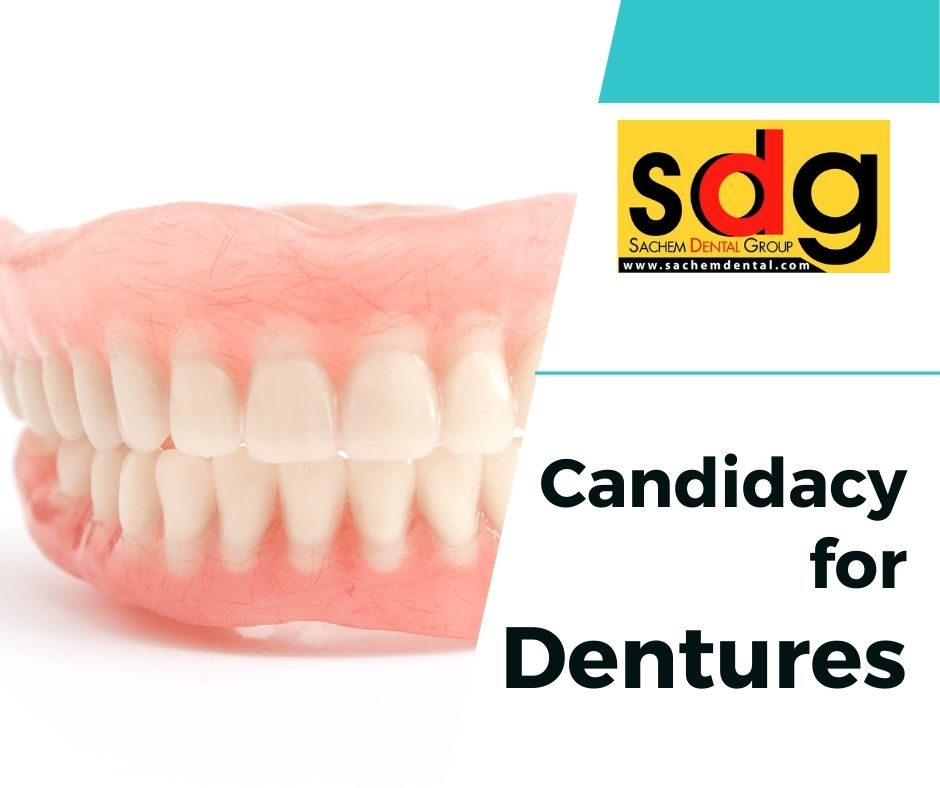
Our Suffolk County dentist offers a few different options for dentures. Your candidacy will depend on a few things like the number of teeth that you’re missing, the condition of your bone ridge/jaw bone, and your budget.
Types of Dentures
Sachem Dental Groups offers the following types of dentures:
Partial Dentures
A partial denture is a removable device made for patients who are missing several teeth but still have some remaining ones that are healthy and don’t need to be removed. Partials are held in place with small clasps that hook onto the existing teeth. There are three different kinds of partial dentures that are commonly made.
- Metal Cast Partials ー A cast partial has a metal base with acrylic teeth and hard gum-tissue-colored material attached to it. The teeth come in a variety of different shapes, sizes, and shades. When selecting which template to use, we try to match your remaining natural teeth as much as possible.
The custom metal framework makes this kind of partial the longest-lasting, best-fitting, and most affordable option. It’s one of the most common types of partial dentures we offer. As far as a long term investment goes, a cast partial might be best because if you ever need to have another tooth removed in the future; in many cases, it can easily be added to your metal framework partial for a minimal fee. This isn’t possible with all partials.
- Acrylic Partials ー Acrylic partials are made from a base that’s the same acrylic material that the “gum tissue” from a cast partial is made from. And they use the same kind of acrylic teeth. The only metal on an acrylic partial is the metal clasps that go around your teeth. Most of the time these clasps can be placed in an area further back in your mouth where they won’t be as noticeable.
- Flex Partials ー Flex partials are made from an acrylic type of material that is the same color as your gum tissue, but the material isn’t hard like regular acrylic partials. Flex partials are just that – flexible. They have some give to them, which can make them more comfortable for some patients too wear. There are no metal clasps with flex partials. Instead, there are small wings, which are made of the same flexible material that wrap around your teeth to keep that partial in place. However, flex partials may have a hard time staying in place (depending on which area of your mouth it fits in) and teeth can’t be added to them.
Traditional Full Dentures
Traditional dentures are acrylic plates that have acrylic teeth on them. Upper dentures stay in place by forming a suction with the roof of your mouth. Lower dentures sit on the bone ridge.
These prosthetics do take some getting used to but most people are able to wear them comfortably after some time. In some cases, denture adhesive will be needed.
Since upper dentures cover the roof of the mouth, they can be quite bulky to some people. If you have a strong gag reflex, then you’re probably not the best candidate for a traditional full upper denture.
If you have a shallow bone ridge, then a lower denture is likely to float on your gums causing sore places because they’re constantly moving. In this case, we may recommend that you go with a different type of denture.
Snap-on Overdentures
Overdentures are great for patients who have a strong gag reflex or a shallow bone ridge. This appliance incorporates implants to make a denture with small connectors built into it. When lined up correctly, the denture pops onto the implants like snap buttons on a jacket.
Being able to snap your dentures securely in place means there’s no need for messy adhesive or worrying about your “plate” rocking back and forth. And since a lower will be more secure, you won’t have to worry about it floating around and causing you discomfort.
Snap on dentures are meant to be removable, so you’ll still need to take them out every night before you go to bed.
The connectors on these dentures do wear out over time, so you’ll need to get them replaced every now and then. Fortunately, the process to do so only takes a couple of minutes.
Good candidates for this type of denture need to have the right amount of jaw bone to hold at least two implants in place. A 3D CBCT scan will allow us to measure the bone to see if implants are an option.
All-on-Four Dentures
All-on-Four dentures also incorporate implants. This hybrid appliance is the next step up from a snap-on overdenture and is a non-removable, permanent restoration. Most people prefer them for full mouth reconstruction instead of wearing traditional dentures.
First, we will need to place a minimum of four implants per arch. Then we will have a full arch appliance made that looks like a cross between a denture and an extended dental bridge. The “plate” portion is cut out, so it looks more like a connection of teeth with a bit of gum tissue material added to it. This streamlined device has openings in it that correspond with the location of the implants. An attachment is placed through each opening and into the hollow implant.
An All-on-Four denture is a fixed appliance so you don’t have to worry about taking it out at night. You will, however, need to keep it thoroughly clean so that your implants and the gum tissue around them stay healthy. Our Long Island dentist and hygienist will provide you with tips and tricks on how to do so.
Dentures in Long Island
If you’re interested in replacing your teeth with a denture, we can provide a professional assessment as to which type of prosthesis is appropriate. We’re happy to review all of your options with you well ahead of time. Call Sachem Dental Group of Long Island to schedule a consultation today.
